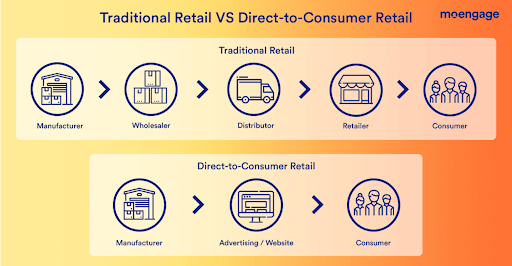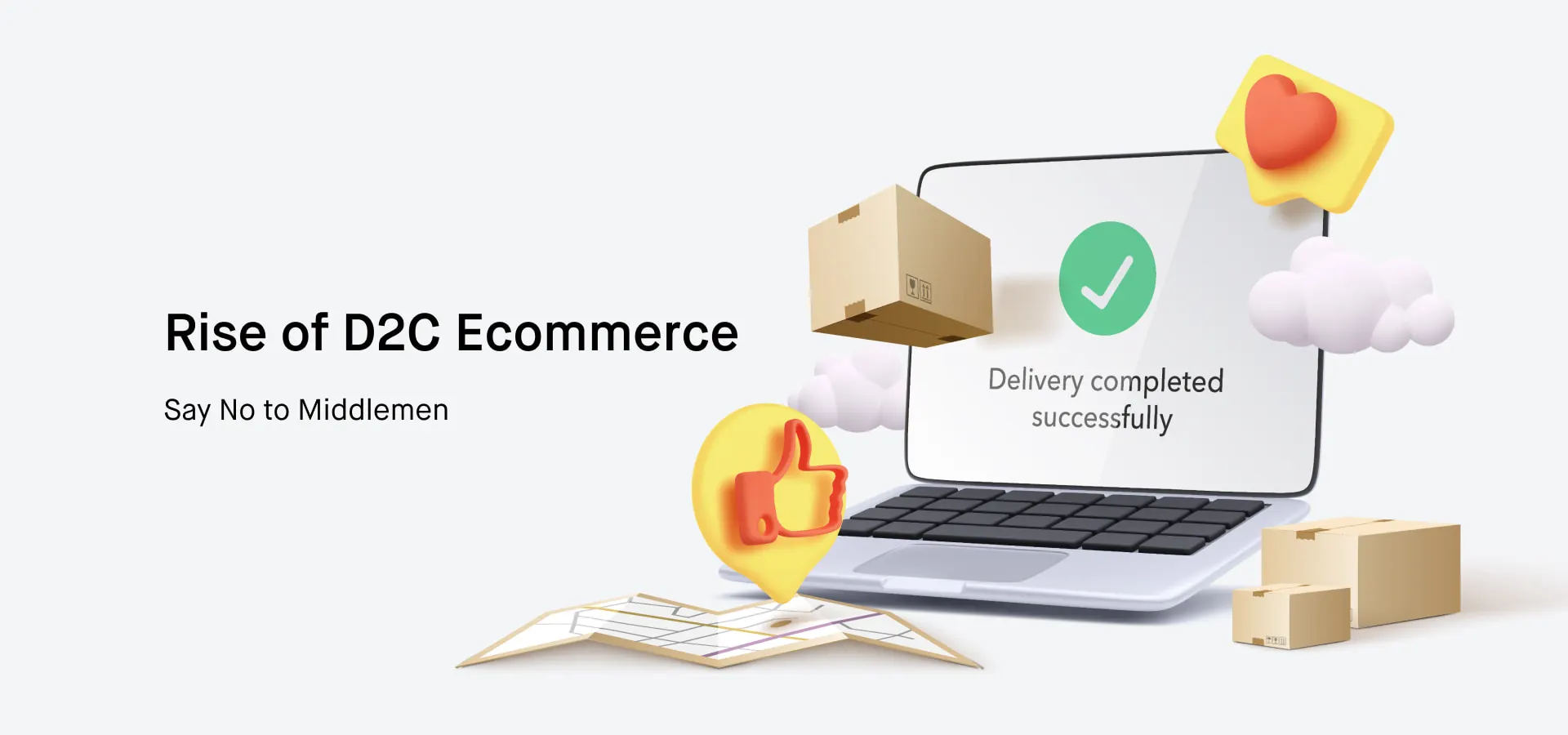Why Every Startup Should Consider a D2C Ecommerce Agency Early On
Wiki Article
Exploring the Possible of D2C Ecommerce: A Comprehensive Guide for Organizations
The D2C ecommerce design provides a substantial change in just how brand names engage with customers. It makes it possible for companies to bypass conventional retail channels, fostering much deeper links and potentially boosted earnings margins. However, this strategy is not without its intricacies. Comprehending the nuances of D2C ecommerce is vital for brand names aiming to prosper. What strategies can they adopt to navigate this progressing landscape successfully? The solutions may redefine their organization strategies.Comprehending the D2C Ecommerce Design

Trick Conveniences of D2C Ecommerce for Brands
The D2C ecommerce design provides brands considerable advantages, particularly regarding increased earnings margins. By getting rid of intermediaries, business can preserve a bigger share of sales revenue. In addition, this direct partnership with clients promotes enhanced brand commitment, encouraging repeat acquisitions and lasting interaction.Enhanced Profit Margins

Boosted Brand Name Commitment
Structure on the financial advantages of D2C ecommerce, improved brand name commitment emerges as another necessary benefit for business engaging directly with consumers. By establishing a direct link, brand names can foster deeper partnerships with their clients, getting insights into actions and preferences. This direct interaction permits even more personalized marketing methods, which reverberate strongly with customers. Furthermore, brand names have the possibility to manage their messaging and consumer experience, strengthening brand name values and building count on. When clients really feel an individual link, they are extra most likely to return, advocate for the brand, and participate in area involvement. Inevitably, enhanced brand commitment not only drives repeat acquisitions but additionally grows a passionate customer base, more solidifying a brand name's position in the market.Difficulties Dealt With by D2C Brands
D2C brand names encounter several considerable challenges that can affect their success. Inventory administration concerns can bring about equip lacks or excess, complicating operations and customer fulfillment. Furthermore, advertising budget restrictions often limit the capability to efficiently get to and involve target market.Supply Management Issues
Reliable stock administration provides a powerful challenge for many brands running in the direct-to-consumer (D2C) area. These brands frequently face varying need, which can bring about overstock or stockouts, eventually influencing client fulfillment and earnings. Additionally, the absence of advanced stock monitoring systems can cause disparities in between actual supply levels and reported information, making complex order satisfaction. The diverse range of items D2C brands usually offer additionally complicates inventory management, as variations in dimensions, styles, and shades require even more meticulous oversight. In addition, many D2C services might battle with restricted warehousing abilities, causing ineffective use of space and resources. Consequently, reliable inventory monitoring continues to be a critical hurdle for D2C brands going for lasting growth and functional efficiency.Marketing Budget Constraints
Navigating advertising budget plan restraints is a significant obstacle for several direct-to-consumer (D2C) brand names. Minimal funds often limit these firms' ability to buy all-inclusive advertising methods, causing lowered visibility in an open market. D2C brands frequently come to grips with the need to make the most of return on investment (ROI) while targeting specific target markets effectively. This obstacle is intensified by rising expenses in electronic advertising and marketing and the necessity to allot funds across numerous channels, including social media sites, search engines, and e-mail advertising. Many D2C brands have to innovate affordable advertising and marketing solutions, leveraging natural development strategies and influencer partnerships. Eventually, successfully maneuvering these spending plan constraints is vital for sustaining development and achieving long-lasting productivity in the developing ecommerce landscape.Approaches for Building a Successful D2C Ecommerce Business
As consumers increasingly look for straight links with brands, developing an effective D2C ecommerce company needs a calculated approach that prioritizes customer engagement and depend on. One reliable approach is to create compelling brand stories that reverberate with target market, fostering psychological links. Using social networks platforms can enhance visibility and facilitate two-way communication, allowing brand names to engage directly with customers.Moreover, individualized experiences via customized marketing efforts can significantly improve customer retention and commitment. Executing commitment programs and supplying unique deals can even more incentivize repeat purchases.Streamlining the purchasing procedure is important, guaranteeing a straightforward user interface that improves the buying experience. Additionally, transparent communication concerning delivery and returns constructs trust and motivates consumer confidence.Finally, proactively seeking customer responses and responding to it demonstrates a commitment to renovation and consumer contentment, crucial aspects in the affordable D2C landscape.Leveraging Modern Technology for Enhanced Client Experience
In today's competitive D2C ecommerce landscape, innovation plays an essential duty fit consumer experiences. Organizations progressively make use of advanced devices such as synthetic knowledge, chatbots, and individualized formulas to boost communications and enhance the buying procedure. By incorporating these modern technologies, brand names can give tailored item suggestions based upon individual preferences and shopping actions, promoting a much more interesting experience.Moreover, receptive site layouts and mobile applications guarantee that customers can access solutions flawlessly across different tools. Enhanced settlement remedies, consisting of digital budgets and one-click checkouts, even more streamline deals, making it easier for consumers to make purchases.Data analytics likewise enables businesses to gather insights into consumer behavior, allowing for continuous renovation of offerings and services. Generally, leveraging modern technology not only boosts client contentment however likewise cultivates loyalty, eventually driving lasting success in the D2C ecommerce field.Advertising And Marketing Techniques to Drive D2C Sales
Just how can brand names efficiently capture the attention of customers in a saturated market? To grow in the direct-to-consumer (D2C) landscape, brand names have to utilize targeted advertising and marketing methods. Utilizing social media platforms, brand names can involve consumers via interactive material, influencer collaborations, and user-generated posts. Personalized e-mail projects can likewise promote a feeling of connection, providing tailored promotions based upon customer habits and preferences.Moreover, storytelling plays a crucial duty in distinguishing a brand's story, making it remarkable and relatable. Brands need to spend in seo (SEARCH ENGINE OPTIMIZATION) to enhance presence, guaranteeing their products are quickly discoverable online. Additionally, leveraging data analytics allows organizations to improve their advertising and marketing techniques and comprehend customer trends much better. Ultimately, a multi-channel technique that incorporates imagination with data-driven insights can significantly increase D2C sales, permitting brands to stick out in a congested marketplace.Future Fads in D2C Ecommerce
With the fast advancement of modern technology and customer preferences, the future of D2C ecommerce is positioned for substantial change. Emerging trends suggest a change in the direction of hyper-personalization, where brands utilize information analytics to customize offerings to private customer demands. This modification improves consumer experiences, cultivating commitment and engagement.Moreover, sustainability is ending up being a crucial element, with consumers significantly favoring brand names that prioritize green techniques - D2C Ecommerce Agency. Companies are anticipated to take on clear supply chains and sustainable products to fulfill this demand.The combination of synthetic intelligence and enhanced truth will furthermore reinvent the buying experience, enabling customers to visualize products in their environments before purchase. On top of that, social here business is prepared for to grow, as platforms like Instagram and TikTok facilitate seamless purchasing experiences directly within social media.These patterns collectively symbolize a vibrant future for D2C ecommerce, emphasizing customer-centric methods and cutting-edge modern technologies that redefine consumer communicationsFrequently Asked Concerns
What Industries Advantage Most From D2C Ecommerce?
The present question highlights markets that flourish with direct-to-consumer (D2C) ecommerce. Remarkably, style, charm, electronics, and food industries leverage D2C designs to increase brand name commitment, improve client relationships, and optimize earnings margins successfully.Exactly How Do Shipping Costs Affect D2C Pricing Techniques?
Delivering expenses greatly influence D2C prices methods. Companies should stabilize these costs with affordable rates, considering client expectations and revenue margins. Effective monitoring of delivery can enhance consumer fulfillment and drive sales in direct-to-consumer models.
What Settlement Choices Should D2C Organizations Deal?
D2C companies must supply varied repayment choices, consisting of credit/debit cards, electronic pocketbooks, and get now, pay later on solutions. This selection enhances customer ease, raises conversion prices, and deals with various consumer choices in the on the internet shopping landscape.Just How Can D2C Brands Handle Consumer Returns Properly?
D2C brand names can deal with consumer returns properly by implementing straightforward return plans, providing pre-paid delivery tags, and guaranteeing timely refunds (D2C Ecommerce Agency). Clear communication and streamlined processes improve consumer complete satisfaction and urge repeat organizationWhat Lawful Considerations Exist for D2C Ecommerce Workflow?
Legal factors to consider for D2C ecommerce procedures include compliance with customer security legislations, data privacy policies, intellectual property rights, and tax requirements. Brands need to navigate these intricacies to avoid lawful risks and assure smooth operations. By getting rid of intermediaries, D2C brands can use competitive rates and foster an extra intimate relationship with their customers.The D2C design is identified by its reliance on digital systems, enabling brand names to utilize social media, on the internet markets, and their very own internet sites to involve with customers directly. D2C ecommerce assists in the collection of beneficial client data, allowing brands to tailor their offerings and advertising and marketing strategies effectively, inevitably driving sales and boosting margins. In addition, brand names have the opportunity to regulate their messaging and client experience, strengthening brand name values and constructing count on. As consumers significantly look for straight connections with brand names, establishing an effective D2C ecommerce organization needs a critical method that focuses on client involvement and depend on. D2C brands can take care of client returns successfully by carrying out user-friendly return policies, using pre paid delivery tags, and making certain punctual reimbursements.Report this wiki page